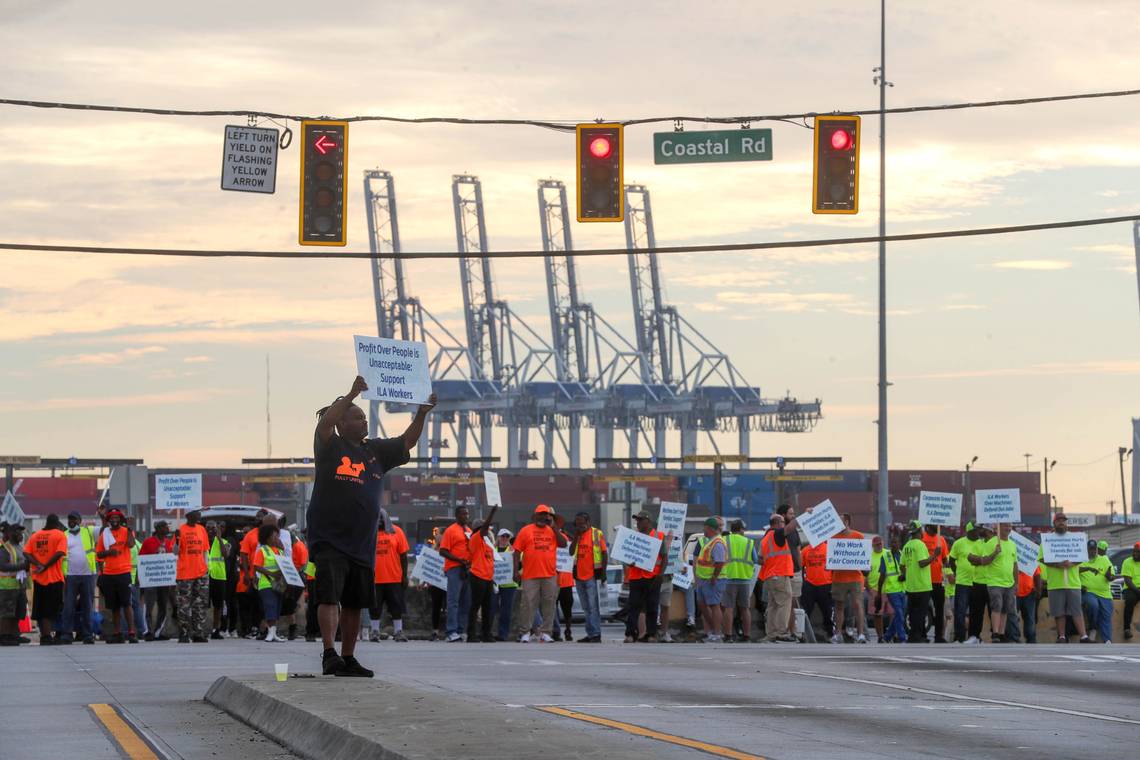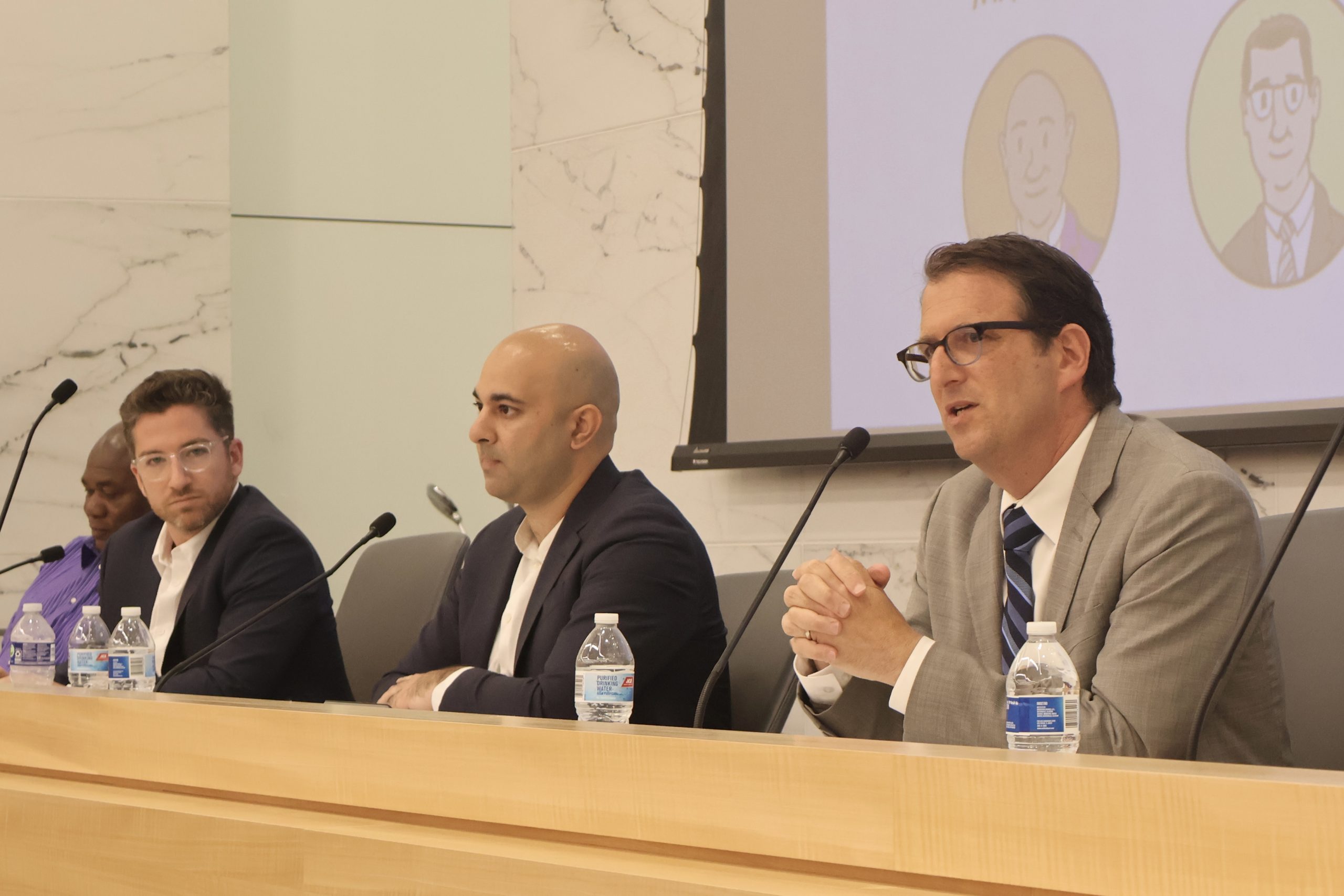[ad_1]
Bananas, imported wine and beer, coffee and car parts — there’s a long list of items consumers across the Carolinas might struggle to find in coming weeks. A dockworker strike on the heels of a destructive hurricane is a main reason why, but shopping habits could become another.
“This is highly unusual,” said Robert Handfield, professor and supply chain expert at North Carolina State University. “Big storms hitting major interstate highways combined with port strikes is unprecedented.”
Hurricane Helene ripped through the Carolinas last week, cutting power to the western parts of both states.
Western North Carolina faced major flooding and widespread destruction. Many people across the Carolinas still are without power. The storm badly damaged major freight routes Interstate 40 and Interstate 26 near the North Carolina and Tennessee border.
Now, dockworkers across the eastern half of the country are on strike. That labor dispute will disrupt supply chains that rely on facilities in Wilmington, Morehead City and Charleston to stock the region with goods.


Grocery store supply chain impact
Mark Ferguson is an associate dean at the University of South Carolina’s Darla Moore School of Business. Grocery stores across the Carolinas that lost power and had to throw out fresh items will result in higher prices and harder-to-find items “probably within days,” he said Wednesday afternoon.
“Short-term, predominantly we’ll probably see fresh vegetables, fruits, anything being imported from South America. To a lesser degree, Europe.”
Ferguson isn’t aware of loss of power at cold storage facilities, where food stocks are kept before going to supermarkets. But when they and grocery stores have to restock, it could be difficult getting items from the West Coast.
”The strike would create that by itself. But it’s going to be amplified by the hurricane because existing inventories are depleted,” Ferguson said. “It’s going to be up and down the East Coast from the port shutdowns, but particularly the Carolinas, Florida, Georgia.”
The port strike could impact anything from larger European auto parts used in South Carolina’s BMW or Volvo plants to French or Italian wines, German beer or cheeses. Large appliances like washing machines or heavy machinery from Europe could become difficult to get.
The strike also could impact produce from the West Coast. How long consumers see those impacts will depend on the strike.
”That’s going to be a problem until the ports reopen,” Ferguson said. “There’s not really an economical way to get fresh food to the East Coast, other than the ports.”
Companies that trade in non-perishable items, particularly large retailers, pre-ordered inventory ahead of the strike to have a month or so of supply.
“I don’t see a real need to panic buy things like electronics, toys, Christmas presents,” Ferguson said. “These big retailers were anticipating strikes.”
Prices are likely to rise on construction materials, due to port availability and tremendous need in Helene’s path, he said.
”There’s going to be a lot of rebuilding,” Ferguson said.
If the strike lasts longer than the month most companies stocked up for, then consumers will begin to feel a steeper impact, he said.


Panic buying could impact product availability
Because retailers began prepping for a possible dock worker strike during the summer, impacts on customers should be minimal for the first couple of weeks, said University of South Carolina research economist Joey Von Nessen. That’s if — and it’s a big if — consumers follow normal buying patterns.
For communities that remember how fast toilet paper flew off the shelves during the height of the COVID pandemic, or tried to buy milk and bread on a snow day, there’s always the threat of panic buying.
“Anticipated shortages can sometimes lead to current shortages,” Von Nessen said. “That creates that self-fulfilling prophecy.”
Both sides of the worker strike have incentive to resolve in quickly, he said, since both are consumers themselves and know how critical that work is to the region’s infrastructure. The port in Charleston contributes to one of every nine South Carolina jobs and has an annual economic impact of $87 billion, Von Nessen said.
Unlike bananas that may spoil if they have to take a longer, more expensive route through the West Coast due to the strike, South Carolina’s main exports or vehicles, tires and agricultural products. “All of those are non-perishable items,” Von Nessen said.
But if the strike goes beyond two weeks, price increases and product shortages could start to rise, he said. It’s an unusual time to forecast, with variables from labor negotiations to markets and roads wiped away by the hurricane and unable to receive goods.
“It is very unusual to have two events like this happen at the same time,” Von Nessen said. “It just magnifies the challenge. It’s important to keep in mind not to panic.”
Interstate loss to drive regional concerns
Even without the dockworker strike, the Carolinas would be facing logistical concerns.
“I-40 and 26 are major thoroughfares for a lot of freight for the east coast,” Handfield said. “So it is hitting many different areas of the country, which will likely impact many different categories. One of the biggest concerns is healthcare supplies for the hospitals in Helene’s path, which typically do not have a lot of inventory.”
It likely will be months before logistical channels improve.
“We need to be thinking about the infrastructure — cell phone towers, roads, power lines and many other elements,” Handfield said. “This will take months to repair and get this community working again.”


Price gouging at retail shops
Too many retailers to name have donated millions of dollars worth of supplies to places ravaged by Helene, said Andy Ellen, president and general counsel for the 2,500-member North Carolina Retail Merchants Association. Yet there’s still a cost to all those diverted trucks and manpower.
“Those are some of the items that would have moved from a distribution center into a store that wasn’t impacted by the hurricane,” Ellen said.
He doesn’t expect a short-term problem getting water, cleaning supplies or plywood to rebuild from the storm. But he does see potential issues with the dockworker strike. About 40% of what ends up on store shelves in the country pass through those ports, Ellen said.
Even if the strike ends quickly but workers get the 50% wage increases they’re seeking, he said, markets could feel it. “That will also potentially impact price points,” Ellen said.
Consumers should expect to see some price increases, including staples like coffee, Ellen said. Customers also can help or hurt supply based on how they shop.
“Regardless of the hurricane and regardless of this strike, it is not a time for consumers to panic,” Ellen said. “We’ve had that before.”
Avian flu drove up egg prices in the past, and the war in Ukraine impacted wheat. COVID stressed items across the supply chain. As prices increase and people buy what they can find, either for themselves or to donate, some people might mistake the natural supply and demand of pricing with price gouging, Ellen said.
“That doesn’t mean that the retailer is doing anything wrong,” he said.
Ellen is hopeful conditions will improve by the holiday shopping season. He’s also concerned as the country is still recovering from high prices due to inflation.
How long the port strike lasts will determine whether it’s a blip or something closer to the COVID-era supply chain challenges.
“We could see some of that in the future,” Ellen said. “If this strike is elongated, we will see higher prices on store shelves.”


[ad_2]
Source: www.yahoo.com



